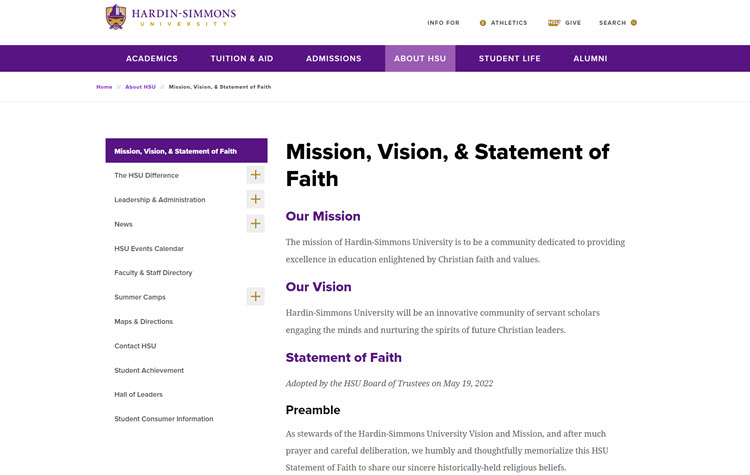Over the last three days, I’ve been more engaged in conversation about Hardin-Simmons University than I have at any time since graduating from Logsdon Seminary with a Master of Divinity degree in 2001. And, I’ve been asked far more questions than I can answer.
This is happening because the University has chosen a new direction, and has made that direction more clear in the publication of a new Statement of Faith.

I’ve attempted to summarize and categorize the unanswered questions I’ve been asked below:
- Precedent. As a Baptist institution of higher education, one would expect a lack of creeds. What prompted the consideration of drafting a statement that appears to be the University’s creed?
- Process. For something as important as a Statement of Faith, one would expect total transparency around the process that produced this document. We already know the Board worked on this for over a year, but little else. Where can we read a public report that explains the full process that led to the University’s new Statement of Faith? (Who was involved and when? What outside experts were consulted? How and when were students, alumni, faculty, and staff involved?)
- Purpose. The initial communication by President Bruntmyer asked people to “take time to read it and meditate on it” while noting it will be added to key University documents, including the Personnel Handbook and Student Handbook. Is the Statement intended to become a doctrinal litmus test that trustees, students, faculty and staff will be expected to pass or at least sign off on in order to remain fully engaged in the life of the University in their respective roles?
- President. President Bruntmyer has been focused on the economic sustainability and long-term opportunities for the future of the University since starting in his role in 2016. Mission, vision, and values drive decision making in all high performing organizations and sincerely held religious beliefs (whether expressed in a Statement of Faith or in other ways) are a vital piece of organizational culture that informs the mission, vision, and values in Christian higher education. How has the President utilized these tools to lead the University in recent major decisions, including the closure of Logsdon, elimination of other degree programs, and creation of the new Statement of Faith? (How will the Statement of Faith inform how he makes decisions going forward?)
- Peculiar Language. A quick review of recent statements of faith in Baptist life as well as statements of faith more generally shows that the use of the word karyotype is not only atypical, but may have been introduced into this body of literature with Hardin-Simmons University’s Statement of Faith. Is the use of the word “karyotype” intended in some way or ways to differentiate HSU’s beliefs from those of other Baptists and more generally from other Christians and/or is this use informed by recent scholarship by one or more members of the University’s faculty?
- Partnership? At its May 23-24, 2022 meeting, the BGCT Executive Board recommended the GC2 statement of faith for consideration at the annual meeting in Waco, Nov. 13-15, 2022. The GC2 statement overlaps significantly with HSU’s new Statement of Faith, including the ways both identify gender and limit marriage. Is HSU leading the change effort in the BGCT, seeking to be an early adopter, being bullied to go along, or is there some other explanation for the shared timeline?
- Pride. June is Pride month. To my knowledge, the Statement of Faith is HSU’s first board approved anti-LGBTQ document. Usually documents as important as a Statement of Faith are disseminated immediately upon approval. Was the decision to delay the announcement so that the news would primarily be shared during Pride an attempt to draw additional attention to the sudden shift of HSU to exclude LGBTQ people or merely a happy coincidence?
- Potential Legal Implications. HSU already has received some form of religious exemption from being responsible to fulfill all of Title IX. Is the new Statement of Faith a tool that will be used in support of expanding this exemption and/or does it offer legal advantages to the university in actively discriminating against LGBTQ students?
- Press. When institutions make milestone decisions, communicating those decisions to internal and external audiences is essential. Why has new Statement of Faith not received the level of publicity it warrants, and how could a document that was prepared over the course of a year or more not be released with a more robust communication plan?
- Prayer. If not for the need to label this with a P to conclude the list of ten questions starting with a “p,” I would have chosen to call it “Thoughts and Prayers.” The Statement of Faith concludes with a section titled “Kindness and Respect.” One must wonder if this is a new phrase that functions much like the more frequently used “thoughts and prayers” to connote some level of thinking but limited action. How were the ideals of kindness and respect embodied in the creation of the HSU Statement of Faith?
So What?
Universities should have clear mission statements, vision statements, and core values. Christian Universities may choose to supplement these with Statements of Faith or other guiding documents that express their sincerely held religious beliefs.
When it comes to Hardin-Simmons University’s decision to adopt a new Statement of Faith, I join with other stakeholders in asking for increased transparency. And, ideally, I’d like that to begin with answers to the ten unanswered questions above.
For More Information
To learn more, please read my previous posts
- Mourning the Loss of Logsdon, Direction of HSU (June 2, 2022)
- Ten Reasons for Concern About HSU’s Statement of Faith (June 3, 2022)
Answers
If you can answer one or more of the questions asked here, please do so. Additionally, if you can point to where HSU has officially answered any or all of these questions, please know those links are most appreciated.